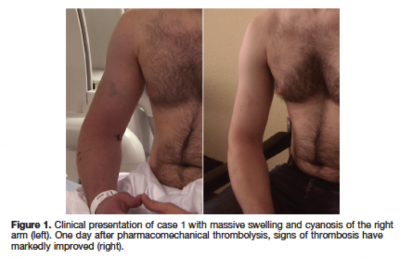 Because of advances in medicine/traumatic care, blunt force trauma and the injuries sustained are usually treated very rapidly, and morbidity directly from trauma has been seen to decrease. However, this may also explain an increase in morbidity indirectly, through Deep Vein Thrombosis and Pulmonary Embolism.
Because of advances in medicine/traumatic care, blunt force trauma and the injuries sustained are usually treated very rapidly, and morbidity directly from trauma has been seen to decrease. However, this may also explain an increase in morbidity indirectly, through Deep Vein Thrombosis and Pulmonary Embolism.
A Deep Vein Thrombosis is a blood clot that forms within a normally functioning vein, and mostly occurs in the leg but can also occur in other parts of the body such as the arm. A DVT becomes a classified as an Embolism when the clot, or piece of the clot breaks off or is dislodged and freely floats about the blood stream. DVTs and Pulmonary Embolisms are dangerous because of their potential to become lodged when the blood reaches the lungs, and can cause an array of problems, potentially causing death.
What causes deep vein thrombosis?
- Trauma – The vein’s inner lining becomes damaged due to injuries cause by a variety of factors including surgery, serious injuries, inflammation, and immune responses
- Lack of blood movement – Sluggish/slow blood flow due to lack of motion can occur after surgery, if you are ill and in bed for long periods of time, or while traveling.
- Genetics or hypercoagulable state – Your blood is thicker or more likely to clot than normal. Inherited conditions, hormone therapy, ceratin cancer drugs and birth control pills increase clotting risk.
How do you prevent deep vein thrombosis?
- Schedule doctor appointments regularly for check ups
- Take all prescribed medications appropriately
- After surgery or while ill, get out of bed and move around. Don’t stay in one place for a long period of time
- During long trips, get up and move around
What puts an individual at risk for deep vein thrombosis?
- Damage to veins resulting from recent trauma or surgery
- Slowing or obstruction of the flow of venous blood
- Being in a hypercoagulable state (increased clotting)
- History of previous injury or immobilization
- Recent history of surgical procedure
- Inherited blood disorder that makes blood thicker
- Sedentary behavior
- Pregnancy and first 6 weeks after giving birth
- Recent or ongoing treatment for cancer
- Smoking
- Overweight / obesity
- Elderly
Look for these symptoms in athletes when deep vein thrombosis is suspected:
See your doctor immediatrly if you have any of the following signs or symptoms:
- Edema (swelling) of the leg or along a vein in the leg
- Pain and tenderness in the leg, which you may only feel when standing or walking
- Warmth in the swollen area of the leg
- Fever
- Erythema (redness of the skin) or cyanosis (blue tinted skin)
- Visible veins at the shoulder or upper arm
- History of previous injury or immobilization
- Recent history of surgical procedure
- Unexplained shortness of breath
- Pain with deep breathing
- Coughing up blood
- Rapid breathing
- Fast heart rate
What else could this be?
- Asthma
- Muscle soreness
- Illness
How do you treat an individual with deep vein thrombosis?
- Medicines
- Anticoagulants (warfarin, coumadin, heparin)– blood thinners; decrease blood’s ability to clot and stop existing blood clots from getting larger. These medications do not break up blood clots that have already formed.
- Treatment with blood thinners usually lasts for 6 months, however –
- If your blood clot occurred after a short-term risk like surgery, treatment time may be shorter
- If you have a history of blood clots, treatment time may be longer
- Treatment with blood thinners usually lasts for 6 months, however –
- Thrombin inhibitors
- Medication that interferes with clotting of blood
- Used as treatment for patients who are not able to take heparin
- Thrombolytics
- Only in life-threatening situations
- Prescribed to quickly dissolve large blood clots that are giving patients severe complications
- Anticoagulants (warfarin, coumadin, heparin)– blood thinners; decrease blood’s ability to clot and stop existing blood clots from getting larger. These medications do not break up blood clots that have already formed.
- Vena cava filter
- Recommended for patients who cannot take blood thinners or have not responded well to them
- Filter inserted into a large vein, the vena cava, to catch blood clots before allowing them to travel to the lungs.
- Filter does not stop new clots from forming
- Graduated compression stockings
- The purpose of the stocking is to create a gentle pressure gradient up the leg to prevent blood from pooling and clotting and to reduce leg swelling
- The length of time of wearing stockings is on an individual basis. Talk to your doctor about how long the stockings should be worn
References
- Engelberger RP, Kucher N. Management of Deep Vein Thrombosis of the Upper Extremity. Circulation. 2012;126:768-773.
- Treat SD, Smith PA, Wen DY, Kinderknecht JJ. Deep vein thrombosis of the subclavian vein in a college volleyball player. Am J Sports Med. 2004;32:529-532.
- Verstraete M. Prevention and treatment of venous thromboembolism after major surgery. Trauma. 1991;1:39-51.